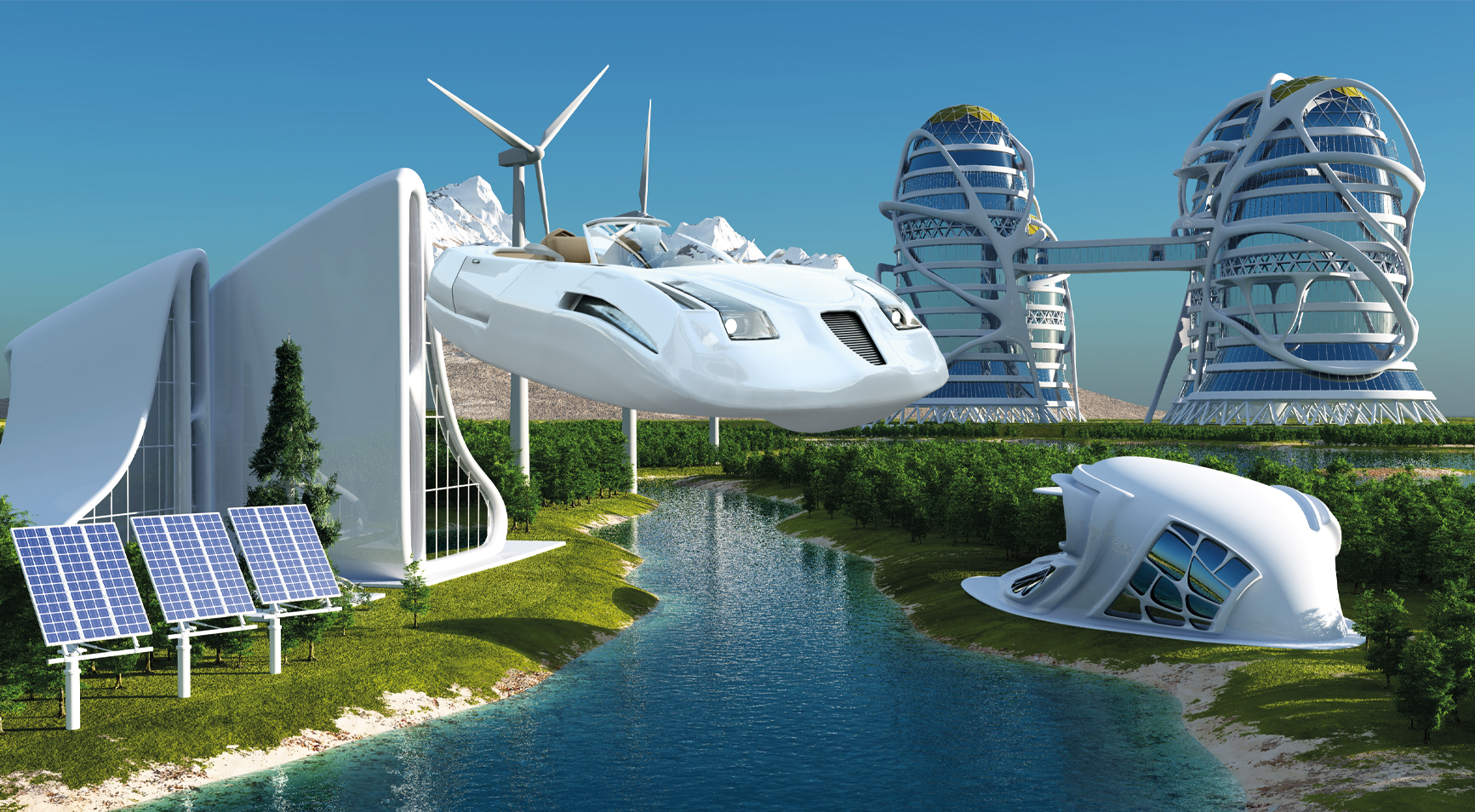If we could have asked the great European canal builders of the 1700s for their mobility predictions, they would have waxed lyrical about bigger and better canals. They would have had no inkling that the advent of railways would soon obliterate their imagined tomorrows.
Asked the same question 100 years later, the 19th-century railway barons would have conjured up images of a train-shaped future.
As we know, the advent of automobiles destroyed that assumption. Our groupthink for the future of mobility — that of swift, silent driverless cars — might be just as wrong.
This future — a shiny, infallible, technologically-advanced tomorrow pushed by automobile interests and fed to us by a largely uncritical media — is no more likely to be correct than the predictions of the great canal builders and the railway barons.
“People of today were born in a railway world…and they expect to die in one,” wrote science fiction author H. G. Wells in 1901 when cars were no longer a novelty yet were not expected to take over the world in the way that they clearly eventually did.1
Ask almost anybody what they think is the future for transport, and they’ll imagine more of what they have already got. Right now that is car domination.
But the motorways built at such great cost between the 1950s and the 1970s — and which, in some places, are deemed so incredibly vital that billions of dollars must be spent on new ones at every opportunity — may suffer a fate similar to that of the canals that are now leisure-focused backwaters and the railway lines that are now rail-trails. We have built ourselves a motor-centric society, and we can only imagine a slightly different future: more roads, dotted with faster, sleeker motor cars, soon to be powered with electricity or hydrogen, but still car-shaped.
When, in the 1800s, the only future imagined was of steel rails and steam trains, towns and cities were eviscerated to incorporate this all-conquering, never-to-be-bettered transport mode.
No policymakers, no bureaucrats, no planners, no government ministers had any inkling that the dominance of railways was to be so short-lived, and that towns and cities so ripped apart by the unstoppable train would be ripped apart again by the seemingly insignificant motor car.
Motor cars came to dominate our lives not by design but by stealth. Few predicted the motor car’s eventual dominance, and it is reasonable to assume that the inability to predict the future afflicts our generation, too.
There could come a time when motor cars are perceived as historically quaint, like steam trains. Holidaymakers of the future may go on “motorway heritage” day trips, wallowing in the nostalgia of journeying on preserved sections of otherwise dismantled roads. This is unthinkable now, but history teaches us that transport modes don’t just evolve but can flip, and usually in the most unexpected ways.
The tech bros may be banking on driverless cars becoming the next disruptive transport mode, but extrapolation is a poor predictor of the future. Removing the driver may not be as disruptive as the technologists think.
Removing the car would be a more significant move, and many global cities are thinking of doing just that, to a greater or lesser degree.2 Helsinki is on the road to far fewer cars.3 Paris has already turned densely-packed motor roads into people-only boulevards and is actively disincentivizing motoring by removing parking places.4 Even Birmingham — Britain’s “motor city,” famous for the “spaghetti junction” motorway knot — is soon to introduce a city-sized “Low Traffic Neighborhood” with through travel by car prevented by barriers and numberplate recognition cameras.5
Ah, but that is Europe’s historic city core, you might say. But cars are being designed out of cities around the globe.
Seoul’s Cheonggyecheon elevated highway is the poster child of a movement called “freeway removal.” Built in 1976, the eight-mile South Korean multi-lane flyover was demolished in 2005, and replaced with a country park and a bus route.6 Further highway removals followed in South Korea. What happened to the motorists and their cars? They dispersed, with no noticeable impact on congestion. Benefits in Seoul have included reducing carcinogenic airborne particulate matter by 21 percent and lowering the city’s summer temperature by 3.6 degrees Celsius.
Santa Monica’s once motor-soaked Third Street was converted into a pedestrian promenade7; Harbor Drive in Portland, Oregon, is now more of a walk than a drive 8; and “tactical urbanism” — think strategic placement of moveable planters — was used to transform New York City’s Times Square into a car-free space, temporarily at first but permanently soon thereafter.9
Residents of these cities would not go back to traffic-clogged streets, and it is likely that even the most motor-centric of cities, for reasons of livability if nothing else, will become much more people-friendly in the near future.
And it could be more than just the removal of a freeway or two; it could be a wholesale return to how cities used to be – before cars, B.C., if you will.
In this tomorrow, the dominant transport modes will be the efficient ones, the healthy ones, the mind-expanding ones, the somewhat older than motoring ones.
The neglected modes of walking, cycling, and public transit — thought by most to be part of history — could make a glorious return, with private car use, even in clean, green, robot-driven motor vehicles, heavily restricted.
This is partly due to climate change (the manufacture of an electric car is a considerable drain on the world’s resources).10 But it also has to do with geometry: automobiles, even computer-drive ones, are hugely inefficient users of space. Look at how much room Birmingham’s spaghetti junction takes up.11 Multi-lane highways are also incredibly costly and, via the well-understood phenomenon of “induced demand,” they rapidly fill with motor traffic anyway, negating their usefulness and requiring building more lanes ad infinitum.12
Fully autonomous flight?
In a report published in August 2021 on the future of mobility, the UK government innovations agency Innovate UK13 predicted that “revolutionary new aircraft” — known as advanced air mobility (AAM) services — could be flitting around the skies within nine years.
Such futuristic air taxis have been the stuff of science fiction since the 1950s, but with advances in avionics, they could be picking you up — autonomously — as soon as 2030, says Innovate UK’s Transport Vision 2050.14
AAMs already exist — clever, clean and cute — but they will likely remain as executive toys, monitored, if not always piloted, by expensive humans. It’s improbable that AAMs will be ferrying ordinary folks around cities any time soon.
It is not that the technology is not advanced. For example, Elroy Air’s autonomous cargo aircraft — the Chaparral — is equipped with sensors that allow it to detect moving obstacles when travelling through the sky.15 And aviation’s largest companies are also working on the concept of autonomous flight.
The Wayfinder project — based at Acubed, Airbus’ innovation hub in Silicon Valley — aims to “develop scalable, certifiable autonomy systems for aircraft, ranging from small urban air vehicles to large commercial aircraft.”16
Modern aircraft are already highly automated, but even the most advanced of today’s autopilot systems follow commands rather than make decisions. The new Boeing 787 Dreamliner still needs humans to get off the ground and land again.
“As pilots we are well aware of the downsides [of automation], and one of us monitors the autopilot like a hawk all the time to ensure it is doing what you want it to do,” Dreamliner pilot Pete Smith told me. “If an engine fails during takeoff, the airplane yaws towards the dead engine.”
“Pilots have to put in rudder to counteract this and rotate the airplane to climb away from the runway while maintaining the wings level. The B787 can now recognize this loss of thrust and the associated yaw. It puts in rudder to counteract the yaw, but it doesn’t put exactly enough in, otherwise the pilots would find it harder to identify which engine had failed.”
Clever stuff. But for now, and probably for many years yet, fully autonomous flight is unlikely to go mainstream. And sorry for those still waiting for their jet-packs but, for obvious safety reasons, everyday journeys may never go aerial.
Connected bicycles and cars
Champions of autonomous mobility point out that some rail lines have been driverless for many years. This is true: the Docklands Light Railway (DLR) — with its regular services into the City of London — has operated driverless trains since it opened in 1987.
But the DLR is a closed-loop with relatively simple operational needs. Autonomous flight — just like autonomous motoring — cannot yet cope with the bewildering complexities of real life.
Driverless cars may already operate semi-successfully in Chandler, Arizona, where the weather is almost always clear and dry, and the wide roads have been optimized for use by motor vehicles.17 Still, such cities are far from the norm.
Autonomous vehicles (AVs) often rely on light detection and ranging technology for deciphering what is ahead, but these LIDAR cameras cannot see through objects. Nor do they work reliably in white-out conditions (snow storms can faze human drivers, too, of course).
There’s a solution to this vision problem: fit road edges and static obstacles with radio beacons. Millions of posts, poles and signs have already been equipped with low-power transponders and can be detected by today’s sensor-equipped cars, and tomorrow’s AVs. The chipping of every item of road furniture is part of a burgeoning new sector: intelligent transport systems (ITS)18
The deployment of these infrastructure-to-vehicle beacons has been consequence-free so far — the posts and poles have no say in the matter — but rolling out ITS everywhere will require something many will consider beyond the pale: chipping humans.
The auto and telecommunications industries wargame this scenario. They are also in cahoots with bicycle brands to place bicycle-to-vehicle (B2V) sensors in high-end cycles.
Bicycle manufacturers such as Trek are working on B2V systems with Ford and other automakers.19
That bicycle makers are working with the “connected car” industry to discover which vehicle-to-everything (V2X) sensor technology works best is seen as a sensible collaboration by many. Finally, cyclists will be safe on the roads, so what’s not to like in it?
For tech companies and rich cyclists, the future will be rosy: connected cars will know exactly where on the highway beacon-equipped bicycles are located and smashes will, therefore, be avoided. However, only the beacon-equipped will be spotted. Those choosing — say, for economic or privacy reasons — not to fit bicycle-to-vehicle beacons will be blamed for being hit by sensor-equipped cars.
And if bicyclists must ride with Radio Frequency Identification beacons, the logical next step is for pedestrians to also sport RFID technology. In clothing at first? Later inserted in the body?20
Chipping humans is so dystopian that perhaps, and hopefully, it will come to nothing.
End of the automobile age
If there is an embryonic new transport mode that is about to rise from seemingly nowhere to become dominant within the next 50 years, it could be a form of micro-mobility — small-powered land vehicles that are safe, swift, and do not require immense areas of precious real estate.
Perhaps the most prescient transport mode in the 1985 Hollywood movie Back to the Future was not the DeLorean flying car but the close-to-the-ground, go-anywhere hoverboard?
But, some might be thinking, “I am wedded to my SUV, I need it for work and to pick up the shopping and cannot do that on a hoverboard”. However, post-2020, those sort of journeys look increasingly anachronistic. The awful COVID-19 pandemic demonstrated that working from home was not just possible; it was beneficial in many well-discussed ways.
In the so-called 15-minute cities of the future21 — where every amenity is designed to be close at hand — mobility will not require travel via space-inefficient SUVs, electric or otherwise, autonomous or piloted.
Tomorrow may never become awash with AAMs or hoverboards. The revolutionary ascent of a wholly new form of transport may not happen. Still, one thing is certain: the age of the automobile will end, and, like the famous drip-drip flip in Ernest Hemingway’s 1926 novel The Sun Also Rises, it will end “gradually and then suddenly.”
References
[1] Anticipations of the reaction of mechanical and scientific progress upon human life and thought, H. G. Wells, 1901.
[4] https://www.itsinternational.com/its3/news/paris-get-rid-70000-parking-spaces
[6] https://www.cnu.org/what-we-do/build-great-places/cheonggye-freeway
[7] https://www.kcet.org/shows/lost-la/how-santa-monicas-third-street-became-a-promenade
[8] https://www.cnu.org/what-we-do/build-great-places/harbor-drive
[10] https://unctad.org/news/developing-countries-pay-environmental-cost-electric-car-batteries
[11] https://vimeo.com/109471765
[13] https://www.gov.uk/government/organisations/innovate-uk
[14] https://www.gov.uk/government/publications/uk-transport-vision-2050
[18] https://rno-its.piarc.org/en/intelligent-transport-systems/what-its
[19] https://www.tomesoftware.com/Trek_Tome-CV2X-B2V-system-with-Ford_Press_Release.pdf
[21] https://www.ted.com/talks/carlos_moreno_the_15_minute_city?language=en








